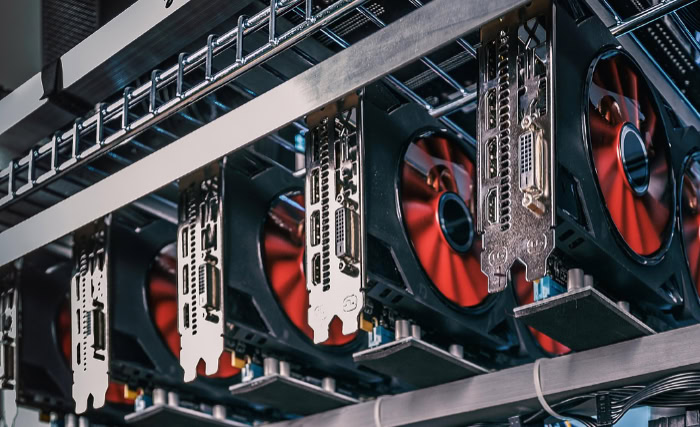What Is Crypto Mining? How It Really Works

Crypto mining is the computational process that secures decentralized networks and issues new coins. It is a system where participants contribute computing power to solve complex puzzles, validating transactions and adding them to a public ledger.
The first to solve the puzzle earns the right to add the next block and receives a reward in cryptocurrency. This proof-of-work mechanism is fundamental to maintaining a trustless, consensus-based record without a central authority.
For anyone curious about how this process functions, what it takes to get started, or the financial trade-offs involved, the answers lie in the mechanics of hashing, the costs of specialized hardware, and the volatile nature of digital asset markets.
The Purpose of Crypto Mining
While the core activity of mining is computational, its true significance is defined by the foundational roles it plays. The process provides the framework for achieving network-wide agreement, establishes powerful economic reasons for participants to act honestly, and builds a formidable defense against malicious attacks.
These three pillars of decentralization, incentives, and security are what give a blockchain its integrity and autonomy.
Enabling Decentralization and Consensus
Mining is the mechanism that allows a global network of computers to agree on a single, shared history of transactions without needing to trust each other. In a traditional financial system, a central entity confirms and records all activity.
Blockchains replace this with a system of consensus, where miners compete to validate new transactions and add them to the ledger. When a miner successfully adds a new block, other participants in the network verify its legitimacy before accepting it.
This distributed agreement ensures that the ledger is consistent across the network and prevents any single party from controlling or manipulating the record of transactions.
Aligning Incentives for Honest Participation
Miners are compensated for their computational work through two main revenue streams: block rewards and transaction fees. A block reward consists of newly created cryptocurrency awarded to the miner who successfully solves the computational puzzle and adds the next block to the chain.
Transaction fees are paid by users to have their transactions included in a block. These dual incentives motivate miners to act in the network’s best interest.
Dishonest behavior, such as trying to approve fraudulent transactions, would result in their block being rejected by the network. The miner would forfeit any potential reward and would have wasted significant resources on electricity, making honesty the most profitable strategy.
Securing the Network Through Proof-of-Work
The proof-of-work model is the security foundation of many cryptocurrencies. It requires miners to expend vast amounts of computational energy to find a valid solution for each block.
This process makes the blockchain extremely difficult and costly to alter. To change a confirmed transaction, an attacker would have to re-mine that block and all subsequent blocks faster than the rest of the network combined. Such an attack would demand an astronomical amount of computing power and electricity, rendering it economically impractical.
The computational cost of mining secures the history of transactions, ensuring that once a transaction is recorded and buried under several subsequent blocks, it becomes effectively permanent.
The Mechanics of Mining

The process of mining follows a structured and competitive sequence to validate transactions and secure the blockchain. It begins when users broadcast transactions to the network, which then enter a waiting pool.
From there, miners select transactions to bundle into a block, then compete to solve a complex puzzle. The winner of this computational race earns the right to add their block to the official chain.
The system includes a self-regulating mechanism to ensure this process occurs at a steady and predictable pace.
From the Mempool to a Block
When a user initiates a transaction, it is broadcast to nodes across the cryptocurrency network. These unconfirmed transactions accumulate in a holding area known as the memory pool, or mempool.
Miners draw from this pool to assemble a new block. Since block space is limited, miners typically prioritize transactions with higher attached fees, as they collect these fees as part of their reward.
Once a miner has selected a group of transactions, they are organized and cryptographically summarized into a single hash called a Merkle root. This root acts as a compact, tamper-proof summary of all the transactions included in that block.
The Merkle root is then placed into the block header, along with other critical data like a timestamp, the hash of the previous block, and a special number called a nonce.
The Basics of Proof-of-Work
Proof-of-work is the competitive process that determines which miner gets to add the next block to the blockchain. The core of this process is hashing.
Miners take the data in the block header and repeatedly run it through a cryptographic hash function. Their goal is to find a hash output that is below a specific target value set by the network, which often means the hash must start with a certain number of leading zeros.
To generate different hash outputs, miners continuously alter a single piece of data in the block header: the nonce. They change the nonce and re-hash the header over and over, performing trillions of calculations per second.
The first miner to produce a hash that meets the network’s difficulty requirement has found the “proof-of-work.” They broadcast their solution and the completed block to the network. Other nodes then verify the solution, and if it is valid, they add the block to their copy of the ledger.
Calibrating Network Difficulty
The difficulty of the proof-of-work puzzle is not static. It is designed to adjust automatically to maintain a consistent interval between the creation of new blocks.
For example, the Bitcoin network targets a new block approximately every ten minutes. The network protocol recalibrates the mining difficulty at regular intervals, typically after a set number of blocks have been mined.
If the total computing power of the network, known as the hash rate, increases and blocks are being found faster than the target interval, the network automatically increases the difficulty. This makes finding a valid hash statistically harder.
Conversely, if the hash rate drops and blocks are found more slowly, the difficulty decreases. This adjustment ensures that the issuance of new coins remains predictable and that the blockchain grows at a stable rate, regardless of how many miners are participating.
Setting Up a Mining Operation
Starting a crypto mining operation requires careful planning and investment in both physical infrastructure and software. Beyond simply acquiring a computer, prospective miners must select specialized hardware suited for the task and decide on a method of participation that aligns with their goals and resources.
Success also depends on managing the ongoing operational demands, including power, cooling, and continuous system monitoring, to ensure the venture remains efficient and profitable.
Hardware and Software Requirements
The hardware used for mining has evolved significantly to keep pace with increasing network difficulty. In the earliest days of cryptocurrency, it was possible to mine effectively using a standard Central Processing Unit (CPU).
As competition grew, miners shifted to Graphics Processing Units (GPUs), which could perform the necessary repetitive calculations much faster due to their parallel processing architecture. Today, for major cryptocurrencies like Bitcoin, the industry standard is the Application-Specific Integrated Circuit (ASIC).
These machines are designed for the single purpose of mining a specific algorithm, offering the highest possible efficiency and hash rate.
Beyond the processing hardware, a successful setup requires several other components.
- Mining Software: A program is needed to connect the mining hardware to the desired cryptocurrency network and mining pool.
- Reliable Power: Mining rigs consume a substantial amount of electricity, so access to a stable and affordable power source is critical for profitability.
- Cooling Systems: Processors generate intense heat while operating. Adequate cooling, through fans or more advanced ventilation systems, is essential to prevent hardware damage and throttling.
- Internet Connectivity: A consistent, low-latency internet connection is necessary to receive new block data and submit completed work without delay.
Choosing a Participation Mode
Miners can choose from several methods to participate in a network, each with different implications for potential earnings and risk.
- Solo Mining: A solo miner works independently, connecting their hardware directly to the cryptocurrency network. If they successfully find a block, they receive the entire block reward and all transaction fees. However, due to the immense competition on major networks, the probability of a single miner finding a block is extremely low, making income highly unpredictable.
- Pool Mining: Joining a mining pool is the most common approach. In a pool, multiple miners combine their computational resources to increase their collective chance of solving a block. When the pool finds a block, the reward is distributed among its members in proportion to the amount of processing power each contributed. This method provides smaller but much more frequent and predictable payouts.
- Cloud Mining: This option allows individuals to rent mining capacity from a large-scale mining operation. The user pays a fee to a company that owns and manages the hardware, power, and maintenance. In return, the user receives a share of the mined cryptocurrency. While it eliminates the need for personal hardware and setup, cloud mining introduces trust issues and typically offers lower margins than running a personal operation.
Operational Essentials for Success
Maintaining a profitable mining operation requires active management and attention to detail. Several elements are crucial for sustaining uptime and efficiency over the long term.
First, a miner needs a secure cryptocurrency wallet to receive and store their earnings. This wallet is the destination for all block rewards and fee payouts.
Continuous monitoring is also a vital task. Miners must use software to track the performance of their hardware, including its hash rate, temperature, and power consumption.
Any downtime or drop in efficiency directly translates to lost revenue, so identifying and resolving issues quickly is paramount. Finally, basic physical maintenance, such as cleaning dust from cooling fans and ensuring a stable power supply, helps protect the hardware investment and keeps it running at peak performance.
The Economics of Mining

Crypto mining is fundamentally an economic activity, where participants balance significant operational costs against potentially lucrative but volatile revenue streams. Profitability is not guaranteed and depends on a delicate interplay between upfront investment, ongoing expenses, and broader market dynamics.
A successful miner must manage their finances as diligently as they manage their hardware, navigating a landscape where efficiency and timing are paramount.
Revenue Streams
A miner’s income is generated from two primary sources for each block they successfully add to the blockchain. The main component is the block reward, a predetermined amount of new cryptocurrency created with each new block.
This reward is the network’s way of minting and distributing its native coin. The size of the block reward is often programmed to decrease over time at scheduled intervals, a process which can significantly impact future profitability.
The second source of revenue is transaction fees. Users of the cryptocurrency network can attach a small fee to their transactions to incentivize miners to include them in a block more quickly.
When a miner assembles a new block, they collect all the fees from the transactions they have included. While transaction fees historically made up a smaller portion of a miner’s income, they are expected to become an increasingly important part of the revenue model as block rewards diminish.
Key Cost Drivers
The costs associated with mining are substantial and can be broken down into several major categories.
- Capital Expenditure: The largest upfront cost is typically the purchase of specialized mining hardware. For competitive mining of major cryptocurrencies, this means investing in expensive ASIC machines that can become obsolete within a few years as more efficient models are released.
- Electricity: Mining is an energy-intensive process, and electricity is the largest ongoing operational expense. The price of electricity is often the single most important factor determining a mining operation’s profitability. Miners constantly seek out locations with the lowest possible power costs.
- Hardware Efficiency: The efficiency of a mining rig, often measured in joules per terahash (J/TH), dictates how much electricity is required to perform a certain number of calculations. More efficient hardware consumes less power to produce the same hash rate, directly reducing operating costs and improving profit margins.
- Facility Overheads: Large-scale operations incur additional costs related to the physical facility. These include rent or construction of a suitable building, industrial-grade cooling systems to manage waste heat, and labor for setup and ongoing maintenance.
Factors Influencing Profitability
The financial viability of a mining operation is shaped by several dynamic factors that are often outside of a miner’s direct control. The network difficulty plays a major role; as difficulty rises, more computational work is required to find a block, which means a miner’s existing hardware will earn less cryptocurrency over time.
Difficulty is directly related to the aggregate competition, or the total hash rate of the entire network. When more miners join the network and contribute computing power, competition for block rewards increases, forcing the protocol to raise the difficulty.
A miner’s share of the total hash rate determines their statistical chance of finding a block.
Finally, the market price of the cryptocurrency being mined is a critical variable. Miners earn their revenue in cryptocurrency, but their costs, especially electricity, are usually paid in traditional fiat currency.
A high coin price can make even inefficient operations profitable, while a sharp price decline can force miners with high costs to shut down their machines. This price volatility introduces a significant layer of market risk to the business of mining.
The Risks of Crypto Mining
While crypto mining can be a profitable endeavor, it is accompanied by a range of significant risks that can impact operations, security, and long-term viability. These challenges extend beyond simple market fluctuations and include hardware failures, external threats, and an evolving regulatory climate.
Prospective miners must weigh these potential downsides carefully before committing capital and resources to the process.
Operational and Hardware Challenges
Mining hardware operates under intense, continuous stress, making it prone to failure. Any downtime for repairs or replacement results in lost revenue, directly affecting profitability.
The constant operation in high-heat environments can shorten the lifespan of expensive components, creating an ongoing maintenance burden.
A persistent challenge is the rapid pace of hardware obsolescence. The mining industry is a technological arms race, with newer, more efficient machines constantly entering the market.
A top-of-the-line ASIC miner can become unprofitable in just a couple of years as its efficiency is surpassed by next-generation models. This forces miners into a costly cycle of reinvestment to remain competitive.
Furthermore, miner income can be highly variable. For solo miners, payouts are rare and unpredictable. Even within a pool, fluctuations in network difficulty and the pool’s own luck can lead to inconsistent earnings.
Security Threats and Market Risks
The cryptocurrency space attracts a variety of security threats that can put a miner’s assets and resources at risk. Scams are prevalent, particularly in the cloud mining sector, where fraudulent companies may sell contracts for mining power that does not exist or provide returns far below what was promised.
Buyers of physical hardware must also be wary of dishonest sellers or faulty equipment.
Another threat is cryptojacking, where malicious software infects a computer and uses its processing power to mine cryptocurrency for an attacker without the owner’s knowledge or consent. On a network-wide level, the concentration of hashing power within a few large mining pools creates concerns about centralization.
If a single pool or a coalition of pools were to control more than 51% of a network’s hash rate, they could theoretically disrupt the blockchain by preventing new transactions from confirming or by reversing their own transactions.
Environmental and Regulatory Hurdles
The high energy consumption of proof-of-work mining has drawn considerable scrutiny from the public and governments worldwide. The significant electricity demand has led to criticism regarding its environmental impact, particularly when the power is sourced from fossil fuels.
This negative attention creates substantial policy risks for miners.
In response to energy concerns, some jurisdictions have imposed moratoriums, punitive taxes, or outright bans on mining activities. The regulatory environment can change quickly, affecting the feasibility and costs of running an operation.
Consequently, the physical location, or siting, of a mining facility is a critical decision. Miners must seek regions with not only cheap and abundant power but also a stable and favorable political climate to ensure their long-term operational stability.
Conclusion
Crypto mining is the foundational process that provides security, consensus, and currency issuance for many decentralized networks. It operates through a proof-of-work system where computational power is converted into a secure and verified public ledger.
The mechanics of this process, from transaction selection in the mempool to the competitive hashing race, are designed to create a trustless environment. Aspiring miners must navigate the practicalities of acquiring specialized hardware, managing significant electricity costs, and choosing a participation method that suits their resources.
Ultimately, mining is a business of margins, where profitability is determined by a careful balance of revenue against operational expenses, all while contending with hardware obsolescence, market volatility, and an evolving regulatory environment. The result is a blend of technological competition and economic calculation that underpins how value and trust are established on a blockchain.


